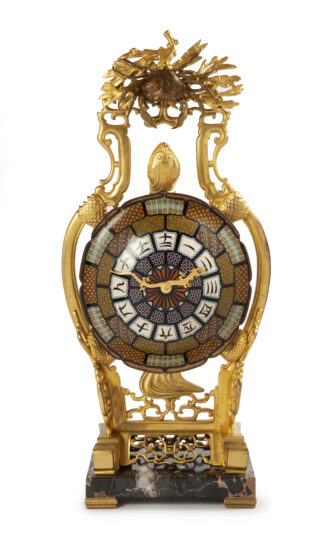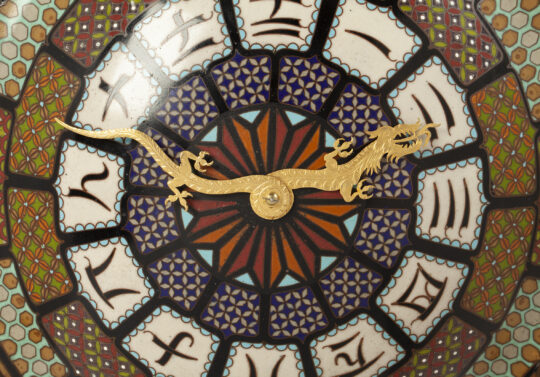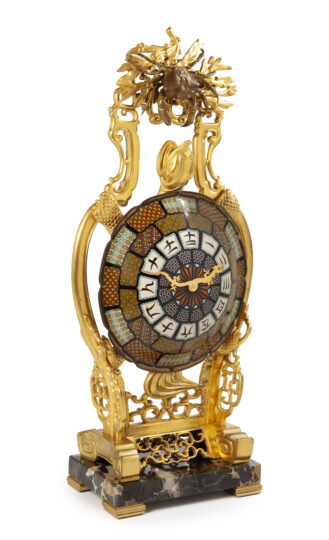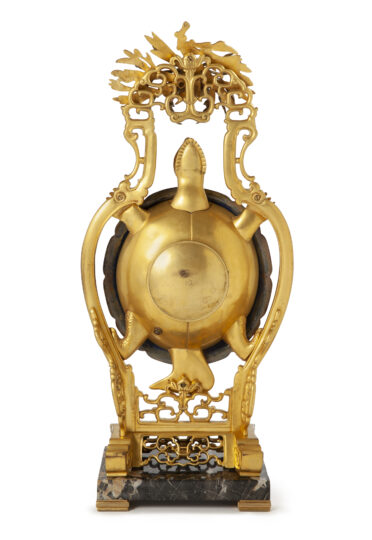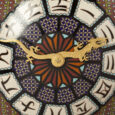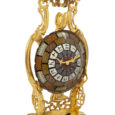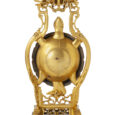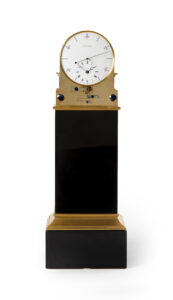PENDULE JAPONAISE Marked: FB 20909 Circa 1870 France
M&R68
PENDULE JAPONAISE
Ascribed to: Émile-Auguste Reiber and L’Escalier de Cristal (retailer)
Marked: FB 20909
Circa 1870
France
Movement
The spring-driven brass movement, marked: FB 20909, consists of going and striking trains. The going train has a Brocot anchor escapement, whilst the rack striking indicates the hours fully and the half hours with one stroke a gong, which has an oriental ring about it. The clock is wound from the back.
Dial
The circular polychrome cloisonné dial has the shape of the shell of a turtle which sneaks up on a crab at the top of the case. The chapter ring consists of twelve stylised oriental characters, the time being indicated by delicately sawn out and engraved gilt brass hands in the shape of a dragon.
Case
The case consists of an open-work gilt cast brass skeleton, which rests on a ‘nero portoro’ marble base.
The maker and designer
Emile-Auguste Reiber worked for companies such as Christoffle and La Maison l’Escalier de Cristal in Paris and made use of Japanese techniques in his creations, for instance certain lacquers and cloisonné enamel. He is regarded as a pioneer of the Japanese style in decorative art in France in the second half of the 19th century. As so often with designers, Reiber began by studying architecture at the age of 21 in Paris in 1847. Three years later he was awarded the Grand Prix. During the 1860s he became to work for Christofle design studio – with whom L’Escalier de Cristal worked – and by the end of the decade he was head designer. Specialized in Japanese metalworking, he mastered the craft of cloisonné and mokume (objects made of various metals) to such an extent that his creations were often mistaken for real Japanese works. His designs, which received a lot of praise, were used by many leading craftsmen of the day. At the Vienna exhibition of 1873, which main theme was “The meeting of East and West”, Christofle exhibited an enamelled vase in Chinese style, designed by Reiber, which was highly appreciated. His designs for enamelled work, clocks and candelabras are in the former Musée Bouilhet-Christofle (see The National Museum of Modern Art, Tokyo, Japonism in Decorative Arts, Tokyo, 1998).
The retailer
The up-market shop of the L’Escalier de Cristal business, founded in 1802, sold clocks, lamps and other art objects to distinguished families in Europe and acquired the epithet fournisseur breveté du Roi in 1819. The company was established in the Palais Royal, a centre of excellence for eminent jewellers, silversmiths, and manufacturers of objets de vertu, for which Paris was famous.
Note
This unusual clock combines European and Asian motifs and styles in an elegant way. The design reminds of 18th century Chinese table screens and the circular dial is inspired by Asian mandalas. The clock illustrates the important influence of the Far East on European decorative art after the reopening of Japan to the West in 1854.
Duration: 1 week
Height: 68 cm.
Width: 31cm.
Depth: 16 cm.
Literature
Theodore Deck (see Ministère de la Culture et de la Communication, Le Japonisme, 1988, plate 166) the cabinet maker Jean-Michel Grohé (see D Ledoux-Lebard, Le Mobilier Français du XIXe Siècle, Parijs, 1989, p. 243)

